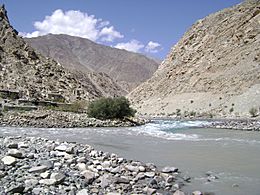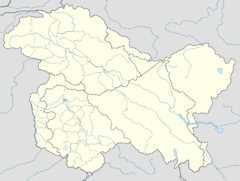Shingo River facts for kids
Quick facts for kids Shingo Riveria |
|
|---|---|

Shingo river (blue) meeting the Dras river in Dalunang
|
|
| Countries | Pakistan, India |
| Provinces | Gilgit-Baltistan, Ladakh |
| Physical characteristics | |
| Main source | Chota Deosai Plains Astore District, Gilgit-Baltistan, Pakistan 34°53′29″N 75°06′46″E / 34.8913°N 75.1129°E |
| River mouth | Indus River Marol 34°44′45″N 76°12′59″E / 34.7459°N 76.2165°E |
| Basin features | |
| Tributaries |
|
The Shingo River is a cool river that flows through two different regions: Gilgit-Baltistan in Pakistan and Kargil in India. It's like a smaller stream that eventually joins a much bigger river, the Indus River. The Shingo River starts its journey in Pakistan. As it flows, it meets other rivers, like the Dras River and the Suru River. Finally, all these waters join the mighty Indus River near a place called Marol.
Contents
The Shingo River's Journey
The Shingo River begins its adventure in the Chhota Deosai plains. These plains are located in the Astore District of Pakistan, just north of Minimarg. From there, the river flows towards the east.
Meeting Other Rivers
Another river, the Shiggar River, also flows east. The Shiggar River starts in the Bara Deosai Plateau, which is north of where the Shingo begins. These two rivers, the Shingo and the Shiggar, meet up before the Shingo River enters the Kargil district in India, near a village called Dalunang.
Once in the Kargil district, the Shingo River gets even bigger. At a village called Kaksar, it joins with the Dras River. The Dras River starts near the Zojila Pass and flows northeast. When the Shingo and Dras rivers combine, the amount of water in the river doubles!
Flowing North
The combined river, sometimes still called Dras or Shingo, continues flowing east. It reaches a small village named Kharul, which is about 7 kilometers north of Kargil. Here, the river makes a sharp turn, a 90-degree bend, and starts flowing north-northeast.
Right at Kharul, another important river, the Suru River, also joins the Dras/Shingo river. It's like the Dras/Shingo river then flows through the path of the Suru River as it turns north. This combined river then travels through the Kharmang District in Baltistan. It passes by a large village called Olding on its left side.
Finally, after this long journey, the river joins the huge Indus River. This meeting point is just a little bit upstream from Marol. The Shingo River is known for being clearer than other rivers in the Ladakh region because its water comes from melting ice. It also flows through a place called Chanigund.
Life Around the Shingo River
The Shingo River flows north of the Line of Control. This line is like a border that separates the parts of Kashmir controlled by India and Pakistan. The biggest town along the river's path is Gultari.
Roads and Connections
There's a road that runs right next to the Shingo River. This road used to connect Kargil to the Astore District. When the river enters the Kargil district, its valley (the land around it) is home to National Highway 1 of India. This important highway connects the regions of Kashmir and Ladakh.
After the river flows back into Baltistan, its valley supports another road called the Shingo River Road. This road is also known as the Kargil–Skardu Road. These roads are very important for people and goods to travel through these mountainous areas.


